Restaurant Information System: Object and Data Modelling Report
VerifiedAdded on 2023/04/21
|13
|2208
|136
Report
AI Summary
This report provides a comprehensive analysis of object and data modelling for the "Vallée de Goût" restaurant's information system. It identifies functional and non-functional requirements, including customer, chef, and supervisor needs. Key use cases such as adding recipes, managing suppliers, and updating stock status are described. The report includes a UML domain model class diagram and event-partitioned system models. It also outlines SDLC tasks for design activities, emphasizing requirement analysis, modular development, database design, GUI creation, unit testing, and system testing. The goal is to develop a customized information system that enhances customer service, improves inventory management, and reduces operational inefficiencies by automating processes and leveraging information technology, with the final system being easily traversable for both customers and staff.
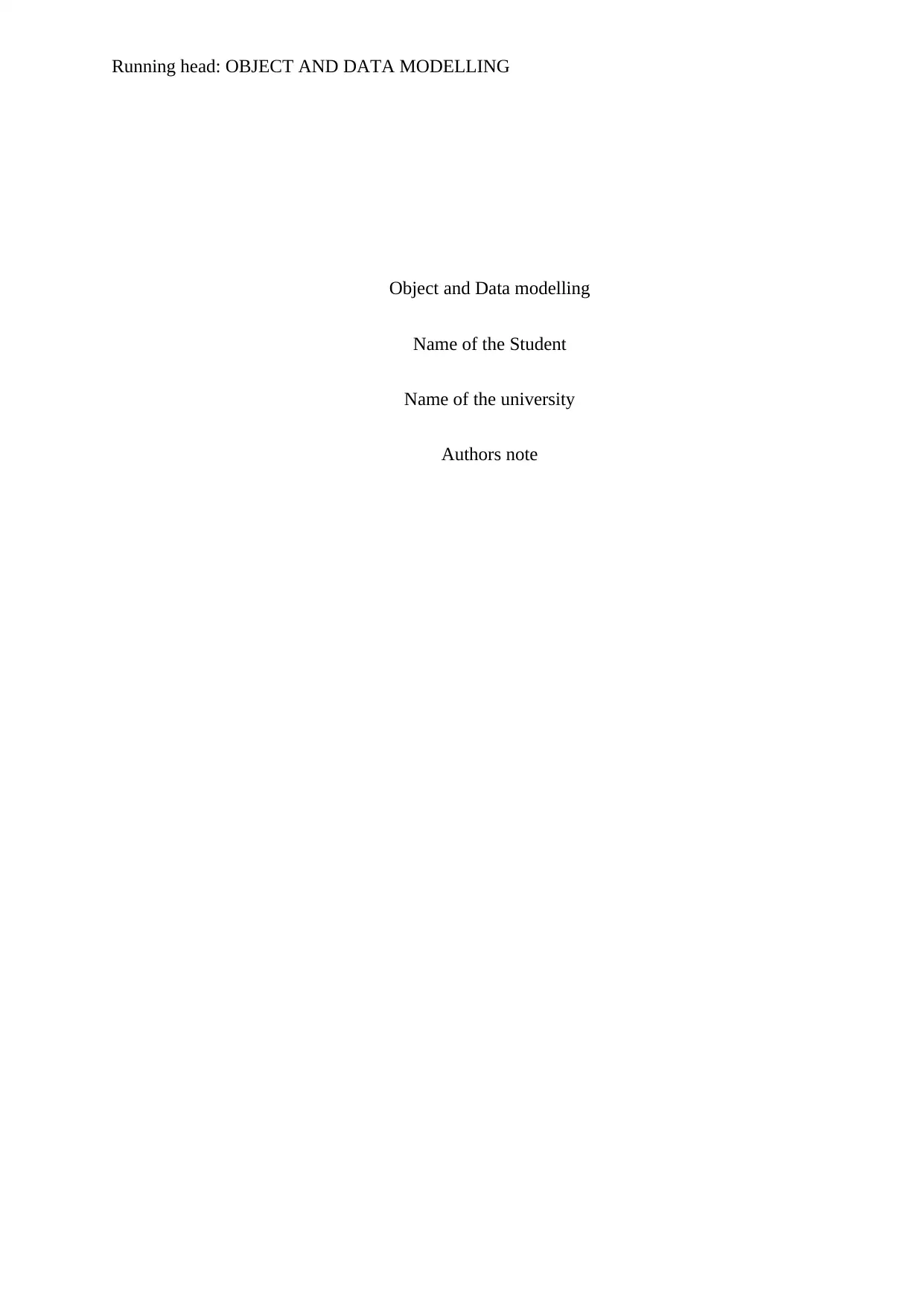
Running head: OBJECT AND DATA MODELLING
Object and Data modelling
Name of the Student
Name of the university
Authors note
Object and Data modelling
Name of the Student
Name of the university
Authors note
Paraphrase This Document
Need a fresh take? Get an instant paraphrase of this document with our AI Paraphraser
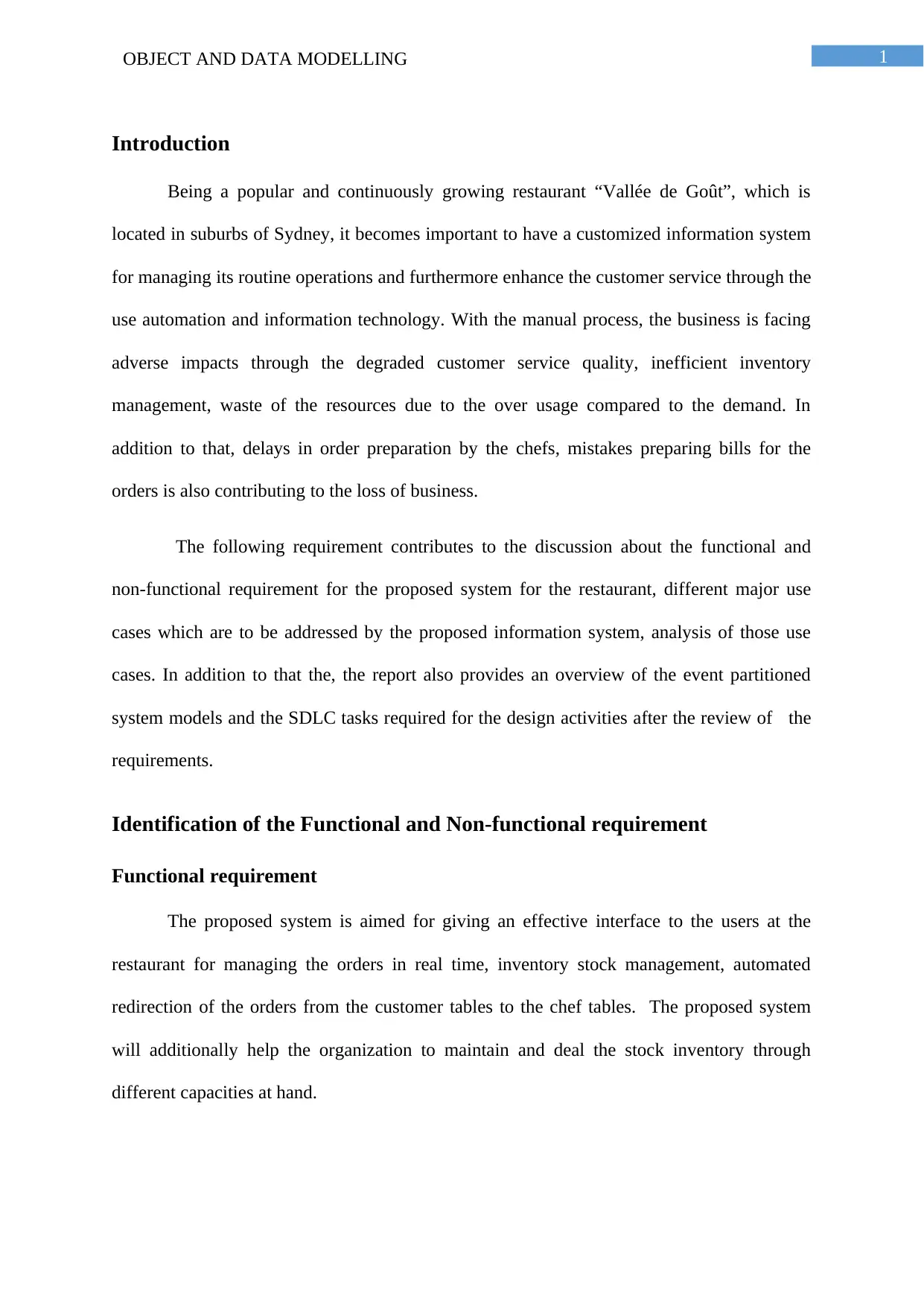
1OBJECT AND DATA MODELLING
Introduction
Being a popular and continuously growing restaurant “Vallée de Goût”, which is
located in suburbs of Sydney, it becomes important to have a customized information system
for managing its routine operations and furthermore enhance the customer service through the
use automation and information technology. With the manual process, the business is facing
adverse impacts through the degraded customer service quality, inefficient inventory
management, waste of the resources due to the over usage compared to the demand. In
addition to that, delays in order preparation by the chefs, mistakes preparing bills for the
orders is also contributing to the loss of business.
The following requirement contributes to the discussion about the functional and
non-functional requirement for the proposed system for the restaurant, different major use
cases which are to be addressed by the proposed information system, analysis of those use
cases. In addition to that the, the report also provides an overview of the event partitioned
system models and the SDLC tasks required for the design activities after the review of the
requirements.
Identification of the Functional and Non-functional requirement
Functional requirement
The proposed system is aimed for giving an effective interface to the users at the
restaurant for managing the orders in real time, inventory stock management, automated
redirection of the orders from the customer tables to the chef tables. The proposed system
will additionally help the organization to maintain and deal the stock inventory through
different capacities at hand.
Introduction
Being a popular and continuously growing restaurant “Vallée de Goût”, which is
located in suburbs of Sydney, it becomes important to have a customized information system
for managing its routine operations and furthermore enhance the customer service through the
use automation and information technology. With the manual process, the business is facing
adverse impacts through the degraded customer service quality, inefficient inventory
management, waste of the resources due to the over usage compared to the demand. In
addition to that, delays in order preparation by the chefs, mistakes preparing bills for the
orders is also contributing to the loss of business.
The following requirement contributes to the discussion about the functional and
non-functional requirement for the proposed system for the restaurant, different major use
cases which are to be addressed by the proposed information system, analysis of those use
cases. In addition to that the, the report also provides an overview of the event partitioned
system models and the SDLC tasks required for the design activities after the review of the
requirements.
Identification of the Functional and Non-functional requirement
Functional requirement
The proposed system is aimed for giving an effective interface to the users at the
restaurant for managing the orders in real time, inventory stock management, automated
redirection of the orders from the customer tables to the chef tables. The proposed system
will additionally help the organization to maintain and deal the stock inventory through
different capacities at hand.
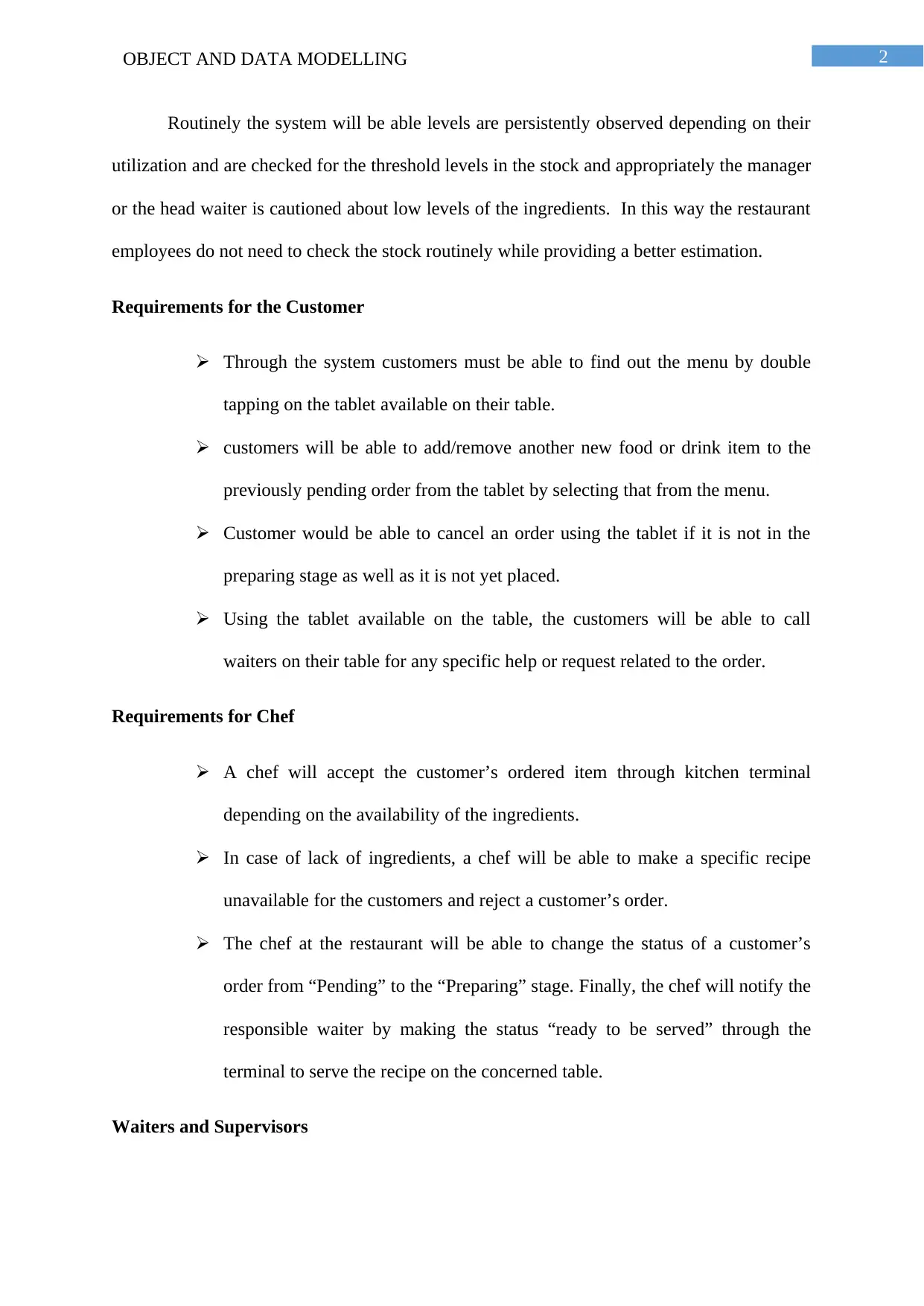
2OBJECT AND DATA MODELLING
Routinely the system will be able levels are persistently observed depending on their
utilization and are checked for the threshold levels in the stock and appropriately the manager
or the head waiter is cautioned about low levels of the ingredients. In this way the restaurant
employees do not need to check the stock routinely while providing a better estimation.
Requirements for the Customer
Through the system customers must be able to find out the menu by double
tapping on the tablet available on their table.
customers will be able to add/remove another new food or drink item to the
previously pending order from the tablet by selecting that from the menu.
Customer would be able to cancel an order using the tablet if it is not in the
preparing stage as well as it is not yet placed.
Using the tablet available on the table, the customers will be able to call
waiters on their table for any specific help or request related to the order.
Requirements for Chef
A chef will accept the customer’s ordered item through kitchen terminal
depending on the availability of the ingredients.
In case of lack of ingredients, a chef will be able to make a specific recipe
unavailable for the customers and reject a customer’s order.
The chef at the restaurant will be able to change the status of a customer’s
order from “Pending” to the “Preparing” stage. Finally, the chef will notify the
responsible waiter by making the status “ready to be served” through the
terminal to serve the recipe on the concerned table.
Waiters and Supervisors
Routinely the system will be able levels are persistently observed depending on their
utilization and are checked for the threshold levels in the stock and appropriately the manager
or the head waiter is cautioned about low levels of the ingredients. In this way the restaurant
employees do not need to check the stock routinely while providing a better estimation.
Requirements for the Customer
Through the system customers must be able to find out the menu by double
tapping on the tablet available on their table.
customers will be able to add/remove another new food or drink item to the
previously pending order from the tablet by selecting that from the menu.
Customer would be able to cancel an order using the tablet if it is not in the
preparing stage as well as it is not yet placed.
Using the tablet available on the table, the customers will be able to call
waiters on their table for any specific help or request related to the order.
Requirements for Chef
A chef will accept the customer’s ordered item through kitchen terminal
depending on the availability of the ingredients.
In case of lack of ingredients, a chef will be able to make a specific recipe
unavailable for the customers and reject a customer’s order.
The chef at the restaurant will be able to change the status of a customer’s
order from “Pending” to the “Preparing” stage. Finally, the chef will notify the
responsible waiter by making the status “ready to be served” through the
terminal to serve the recipe on the concerned table.
Waiters and Supervisors
⊘ This is a preview!⊘
Do you want full access?
Subscribe today to unlock all pages.

Trusted by 1+ million students worldwide
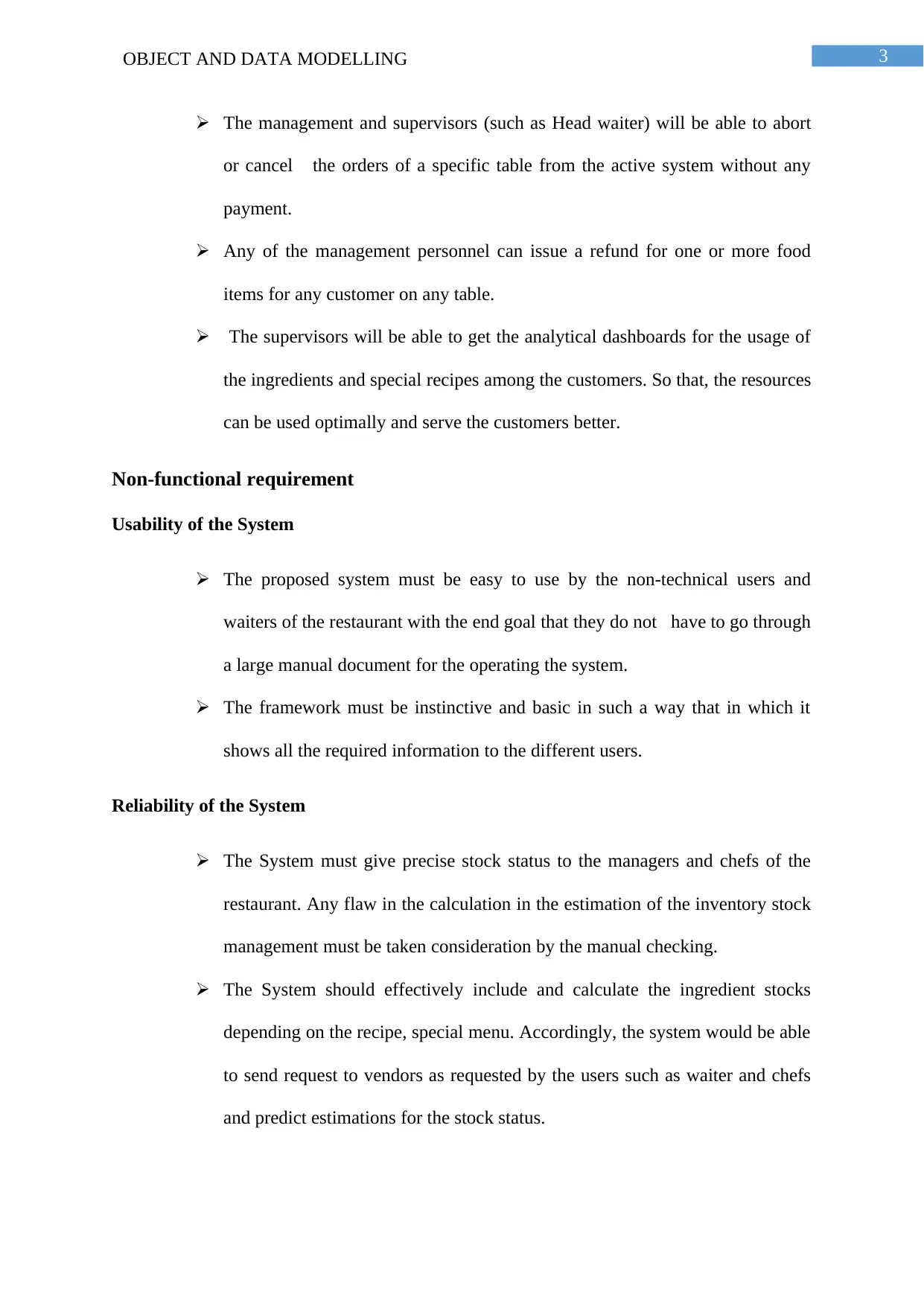
3OBJECT AND DATA MODELLING
The management and supervisors (such as Head waiter) will be able to abort
or cancel the orders of a specific table from the active system without any
payment.
Any of the management personnel can issue a refund for one or more food
items for any customer on any table.
The supervisors will be able to get the analytical dashboards for the usage of
the ingredients and special recipes among the customers. So that, the resources
can be used optimally and serve the customers better.
Non-functional requirement
Usability of the System
The proposed system must be easy to use by the non-technical users and
waiters of the restaurant with the end goal that they do not have to go through
a large manual document for the operating the system.
The framework must be instinctive and basic in such a way that in which it
shows all the required information to the different users.
Reliability of the System
The System must give precise stock status to the managers and chefs of the
restaurant. Any flaw in the calculation in the estimation of the inventory stock
management must be taken consideration by the manual checking.
The System should effectively include and calculate the ingredient stocks
depending on the recipe, special menu. Accordingly, the system would be able
to send request to vendors as requested by the users such as waiter and chefs
and predict estimations for the stock status.
The management and supervisors (such as Head waiter) will be able to abort
or cancel the orders of a specific table from the active system without any
payment.
Any of the management personnel can issue a refund for one or more food
items for any customer on any table.
The supervisors will be able to get the analytical dashboards for the usage of
the ingredients and special recipes among the customers. So that, the resources
can be used optimally and serve the customers better.
Non-functional requirement
Usability of the System
The proposed system must be easy to use by the non-technical users and
waiters of the restaurant with the end goal that they do not have to go through
a large manual document for the operating the system.
The framework must be instinctive and basic in such a way that in which it
shows all the required information to the different users.
Reliability of the System
The System must give precise stock status to the managers and chefs of the
restaurant. Any flaw in the calculation in the estimation of the inventory stock
management must be taken consideration by the manual checking.
The System should effectively include and calculate the ingredient stocks
depending on the recipe, special menu. Accordingly, the system would be able
to send request to vendors as requested by the users such as waiter and chefs
and predict estimations for the stock status.
Paraphrase This Document
Need a fresh take? Get an instant paraphrase of this document with our AI Paraphraser
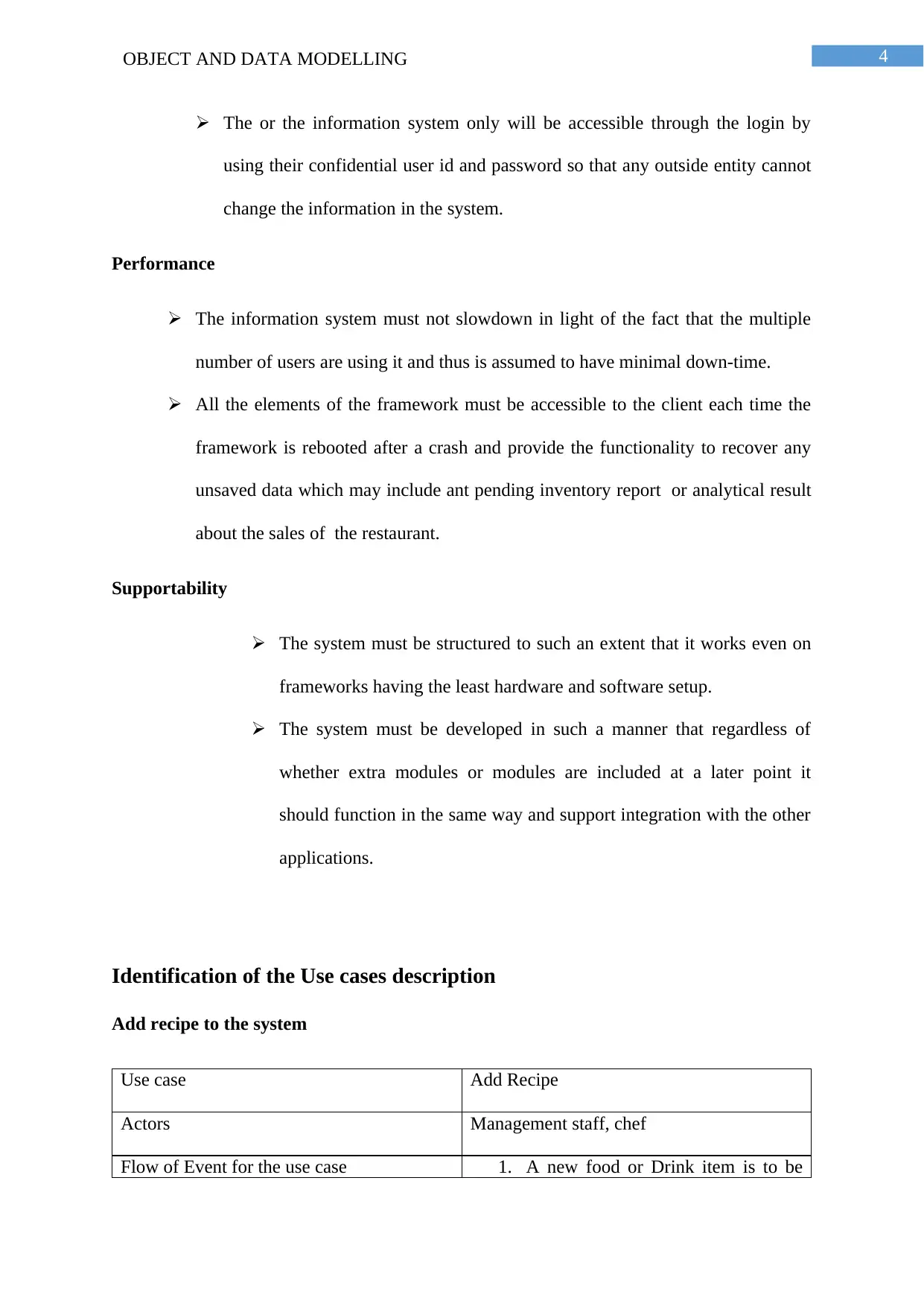
4OBJECT AND DATA MODELLING
The or the information system only will be accessible through the login by
using their confidential user id and password so that any outside entity cannot
change the information in the system.
Performance
The information system must not slowdown in light of the fact that the multiple
number of users are using it and thus is assumed to have minimal down-time.
All the elements of the framework must be accessible to the client each time the
framework is rebooted after a crash and provide the functionality to recover any
unsaved data which may include ant pending inventory report or analytical result
about the sales of the restaurant.
Supportability
The system must be structured to such an extent that it works even on
frameworks having the least hardware and software setup.
The system must be developed in such a manner that regardless of
whether extra modules or modules are included at a later point it
should function in the same way and support integration with the other
applications.
Identification of the Use cases description
Add recipe to the system
Use case Add Recipe
Actors Management staff, chef
Flow of Event for the use case 1. A new food or Drink item is to be
The or the information system only will be accessible through the login by
using their confidential user id and password so that any outside entity cannot
change the information in the system.
Performance
The information system must not slowdown in light of the fact that the multiple
number of users are using it and thus is assumed to have minimal down-time.
All the elements of the framework must be accessible to the client each time the
framework is rebooted after a crash and provide the functionality to recover any
unsaved data which may include ant pending inventory report or analytical result
about the sales of the restaurant.
Supportability
The system must be structured to such an extent that it works even on
frameworks having the least hardware and software setup.
The system must be developed in such a manner that regardless of
whether extra modules or modules are included at a later point it
should function in the same way and support integration with the other
applications.
Identification of the Use cases description
Add recipe to the system
Use case Add Recipe
Actors Management staff, chef
Flow of Event for the use case 1. A new food or Drink item is to be
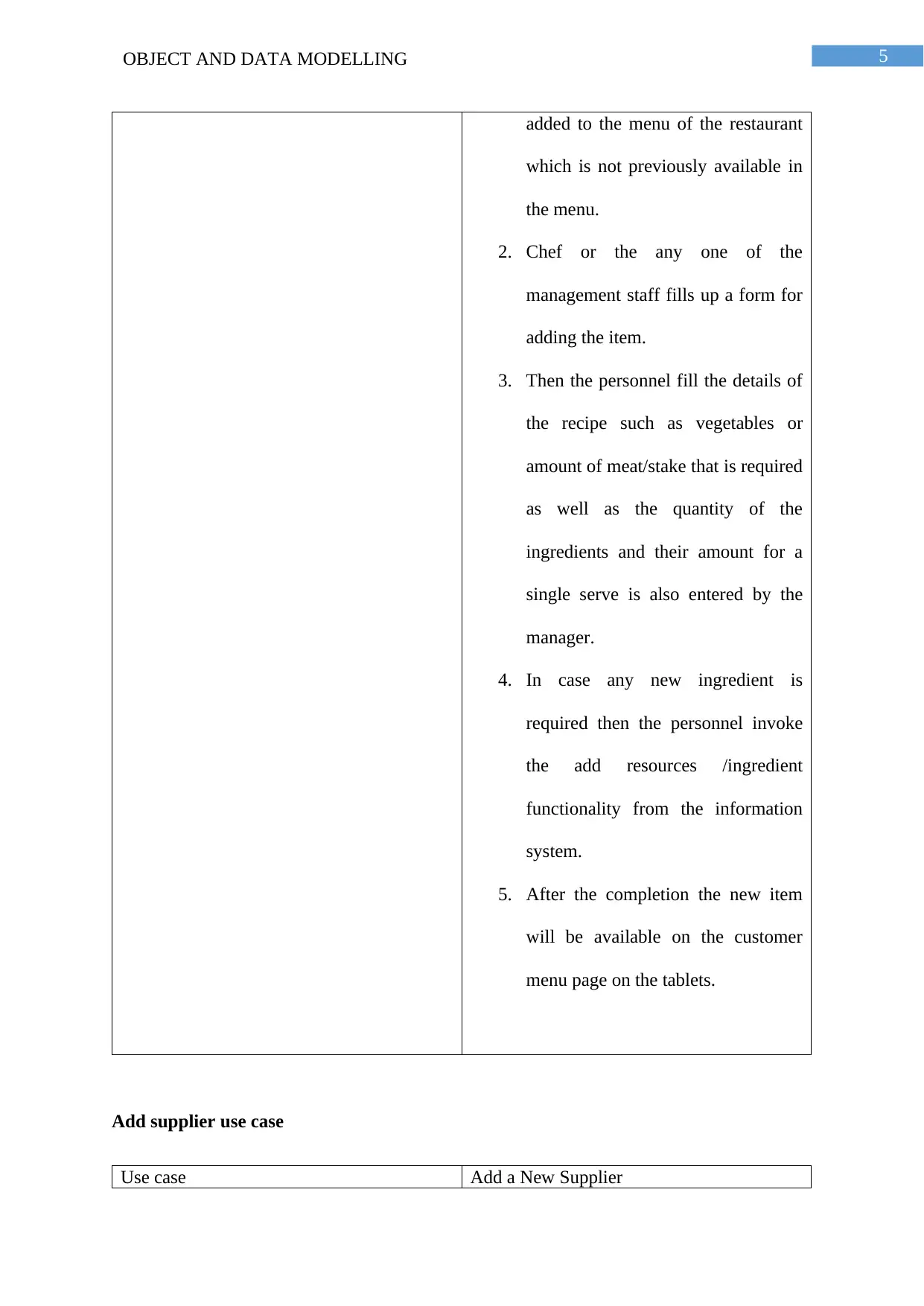
5OBJECT AND DATA MODELLING
added to the menu of the restaurant
which is not previously available in
the menu.
2. Chef or the any one of the
management staff fills up a form for
adding the item.
3. Then the personnel fill the details of
the recipe such as vegetables or
amount of meat/stake that is required
as well as the quantity of the
ingredients and their amount for a
single serve is also entered by the
manager.
4. In case any new ingredient is
required then the personnel invoke
the add resources /ingredient
functionality from the information
system.
5. After the completion the new item
will be available on the customer
menu page on the tablets.
Add supplier use case
Use case Add a New Supplier
added to the menu of the restaurant
which is not previously available in
the menu.
2. Chef or the any one of the
management staff fills up a form for
adding the item.
3. Then the personnel fill the details of
the recipe such as vegetables or
amount of meat/stake that is required
as well as the quantity of the
ingredients and their amount for a
single serve is also entered by the
manager.
4. In case any new ingredient is
required then the personnel invoke
the add resources /ingredient
functionality from the information
system.
5. After the completion the new item
will be available on the customer
menu page on the tablets.
Add supplier use case
Use case Add a New Supplier
⊘ This is a preview!⊘
Do you want full access?
Subscribe today to unlock all pages.

Trusted by 1+ million students worldwide
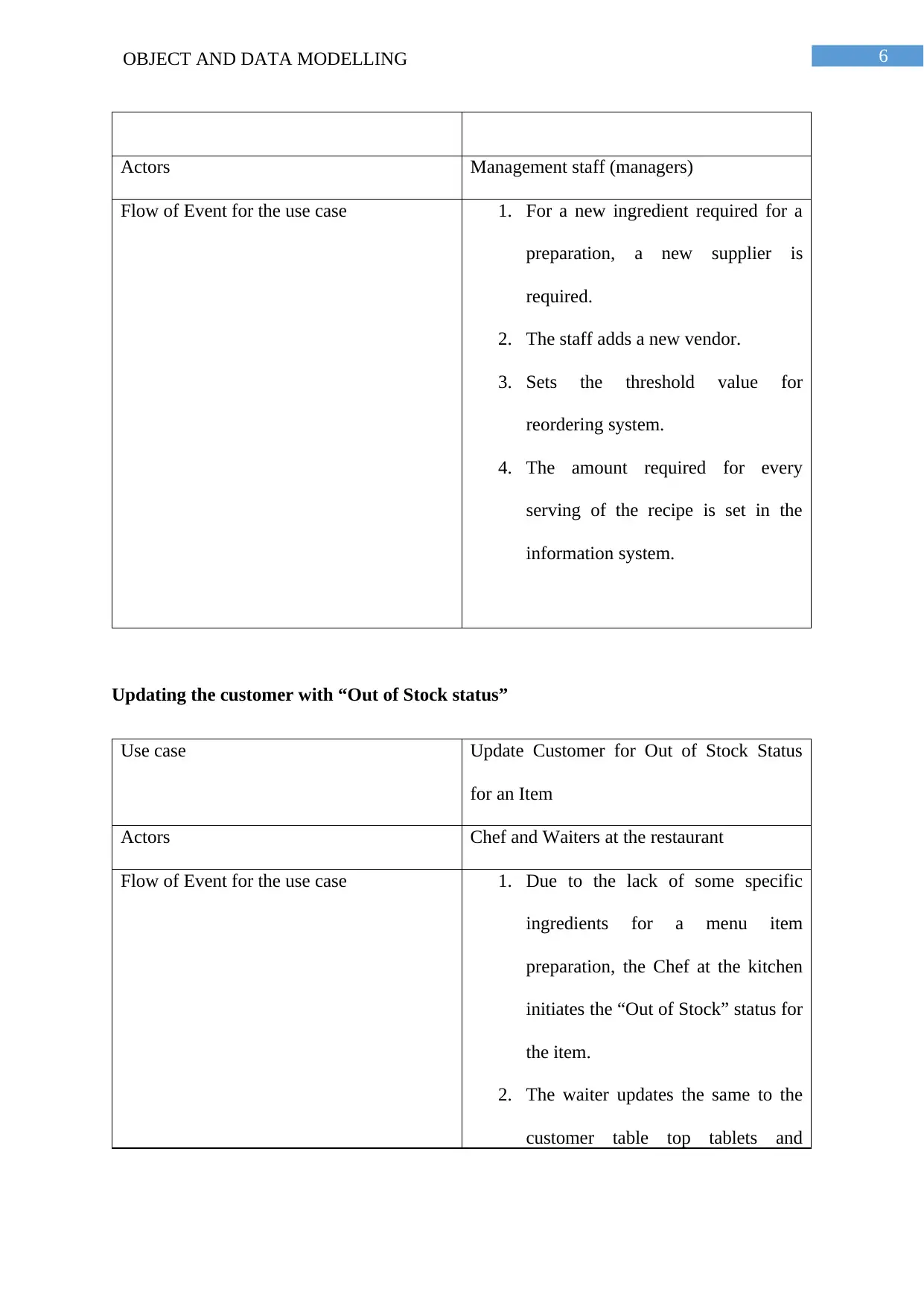
6OBJECT AND DATA MODELLING
Actors Management staff (managers)
Flow of Event for the use case 1. For a new ingredient required for a
preparation, a new supplier is
required.
2. The staff adds a new vendor.
3. Sets the threshold value for
reordering system.
4. The amount required for every
serving of the recipe is set in the
information system.
Updating the customer with “Out of Stock status”
Use case Update Customer for Out of Stock Status
for an Item
Actors Chef and Waiters at the restaurant
Flow of Event for the use case 1. Due to the lack of some specific
ingredients for a menu item
preparation, the Chef at the kitchen
initiates the “Out of Stock” status for
the item.
2. The waiter updates the same to the
customer table top tablets and
Actors Management staff (managers)
Flow of Event for the use case 1. For a new ingredient required for a
preparation, a new supplier is
required.
2. The staff adds a new vendor.
3. Sets the threshold value for
reordering system.
4. The amount required for every
serving of the recipe is set in the
information system.
Updating the customer with “Out of Stock status”
Use case Update Customer for Out of Stock Status
for an Item
Actors Chef and Waiters at the restaurant
Flow of Event for the use case 1. Due to the lack of some specific
ingredients for a menu item
preparation, the Chef at the kitchen
initiates the “Out of Stock” status for
the item.
2. The waiter updates the same to the
customer table top tablets and
Paraphrase This Document
Need a fresh take? Get an instant paraphrase of this document with our AI Paraphraser
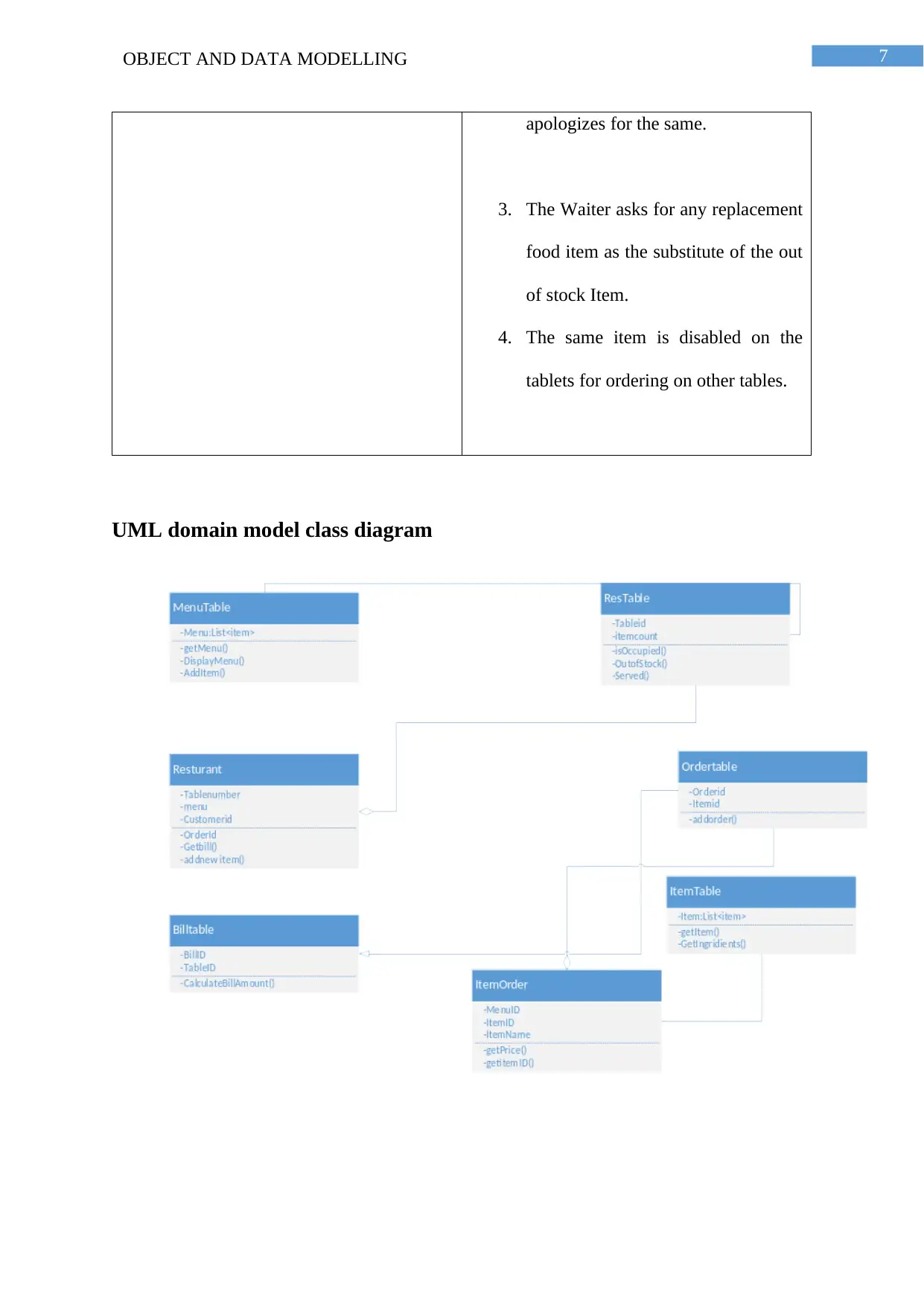
7OBJECT AND DATA MODELLING
apologizes for the same.
3. The Waiter asks for any replacement
food item as the substitute of the out
of stock Item.
4. The same item is disabled on the
tablets for ordering on other tables.
UML domain model class diagram
apologizes for the same.
3. The Waiter asks for any replacement
food item as the substitute of the out
of stock Item.
4. The same item is disabled on the
tablets for ordering on other tables.
UML domain model class diagram
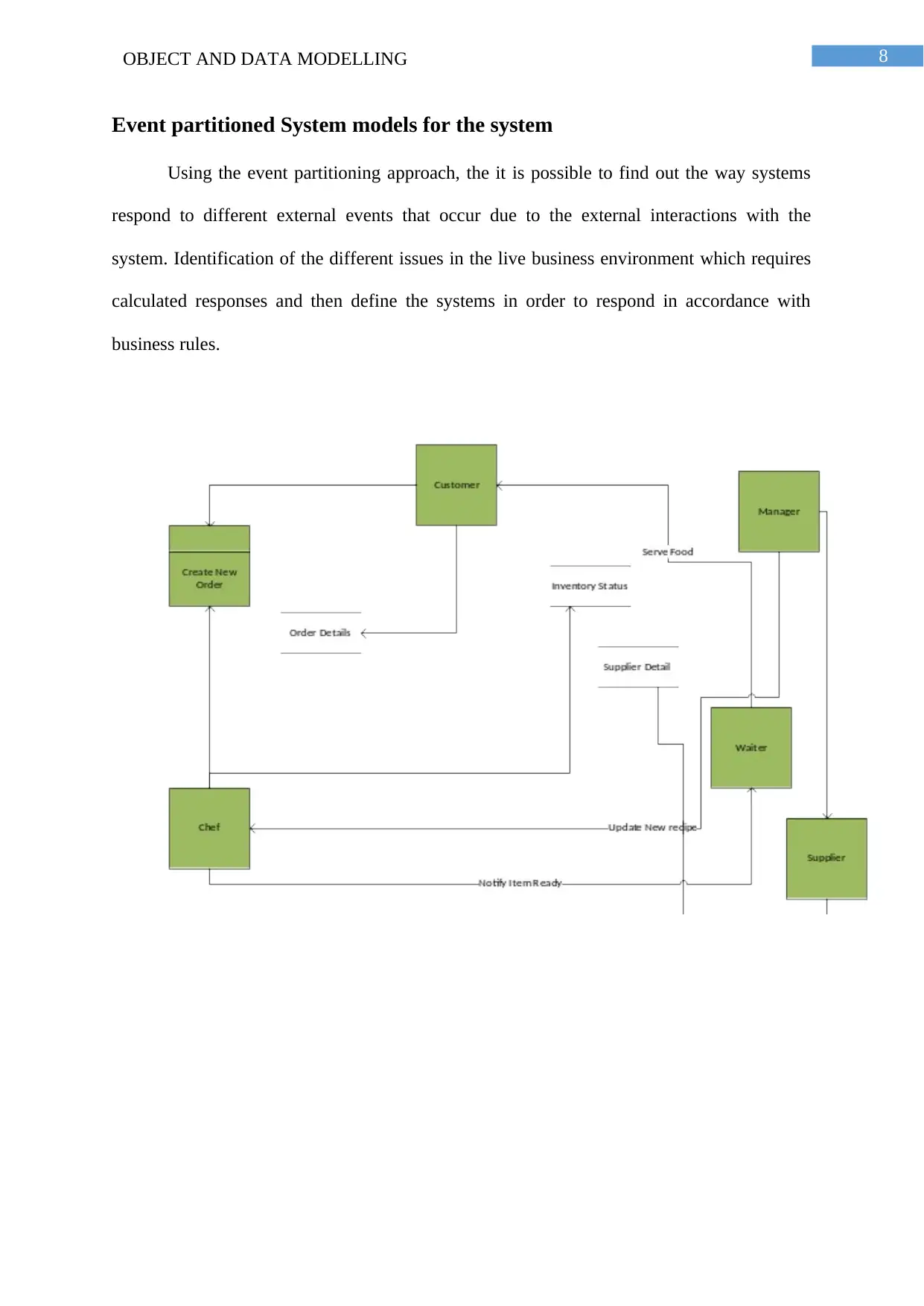
8OBJECT AND DATA MODELLING
Event partitioned System models for the system
Using the event partitioning approach, the it is possible to find out the way systems
respond to different external events that occur due to the external interactions with the
system. Identification of the different issues in the live business environment which requires
calculated responses and then define the systems in order to respond in accordance with
business rules.
Event partitioned System models for the system
Using the event partitioning approach, the it is possible to find out the way systems
respond to different external events that occur due to the external interactions with the
system. Identification of the different issues in the live business environment which requires
calculated responses and then define the systems in order to respond in accordance with
business rules.
⊘ This is a preview!⊘
Do you want full access?
Subscribe today to unlock all pages.

Trusted by 1+ million students worldwide
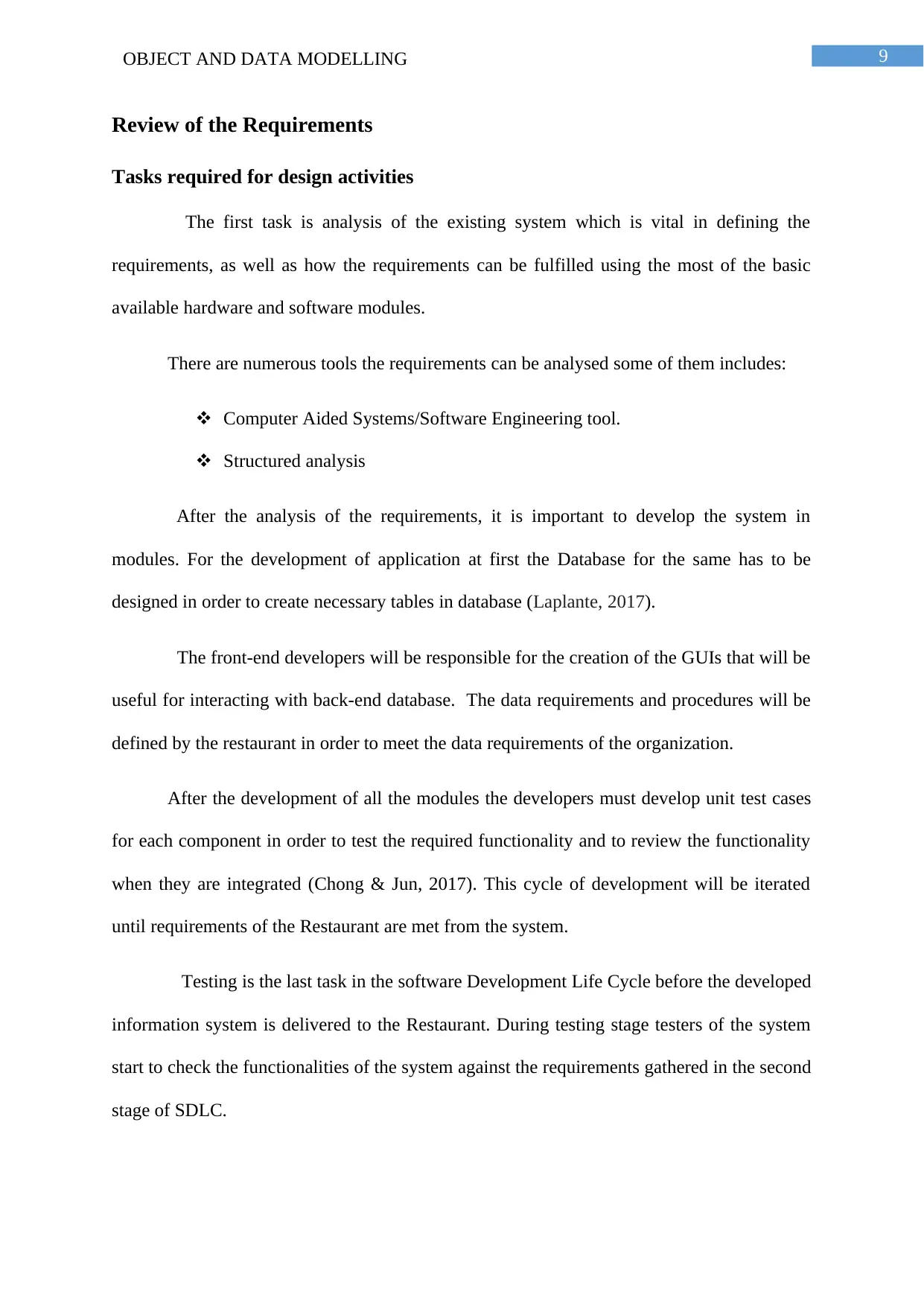
9OBJECT AND DATA MODELLING
Review of the Requirements
Tasks required for design activities
The first task is analysis of the existing system which is vital in defining the
requirements, as well as how the requirements can be fulfilled using the most of the basic
available hardware and software modules.
There are numerous tools the requirements can be analysed some of them includes:
Computer Aided Systems/Software Engineering tool.
Structured analysis
After the analysis of the requirements, it is important to develop the system in
modules. For the development of application at first the Database for the same has to be
designed in order to create necessary tables in database (Laplante, 2017).
The front-end developers will be responsible for the creation of the GUIs that will be
useful for interacting with back-end database. The data requirements and procedures will be
defined by the restaurant in order to meet the data requirements of the organization.
After the development of all the modules the developers must develop unit test cases
for each component in order to test the required functionality and to review the functionality
when they are integrated (Chong & Jun, 2017). This cycle of development will be iterated
until requirements of the Restaurant are met from the system.
Testing is the last task in the software Development Life Cycle before the developed
information system is delivered to the Restaurant. During testing stage testers of the system
start to check the functionalities of the system against the requirements gathered in the second
stage of SDLC.
Review of the Requirements
Tasks required for design activities
The first task is analysis of the existing system which is vital in defining the
requirements, as well as how the requirements can be fulfilled using the most of the basic
available hardware and software modules.
There are numerous tools the requirements can be analysed some of them includes:
Computer Aided Systems/Software Engineering tool.
Structured analysis
After the analysis of the requirements, it is important to develop the system in
modules. For the development of application at first the Database for the same has to be
designed in order to create necessary tables in database (Laplante, 2017).
The front-end developers will be responsible for the creation of the GUIs that will be
useful for interacting with back-end database. The data requirements and procedures will be
defined by the restaurant in order to meet the data requirements of the organization.
After the development of all the modules the developers must develop unit test cases
for each component in order to test the required functionality and to review the functionality
when they are integrated (Chong & Jun, 2017). This cycle of development will be iterated
until requirements of the Restaurant are met from the system.
Testing is the last task in the software Development Life Cycle before the developed
information system is delivered to the Restaurant. During testing stage testers of the system
start to check the functionalities of the system against the requirements gathered in the second
stage of SDLC.
Paraphrase This Document
Need a fresh take? Get an instant paraphrase of this document with our AI Paraphraser
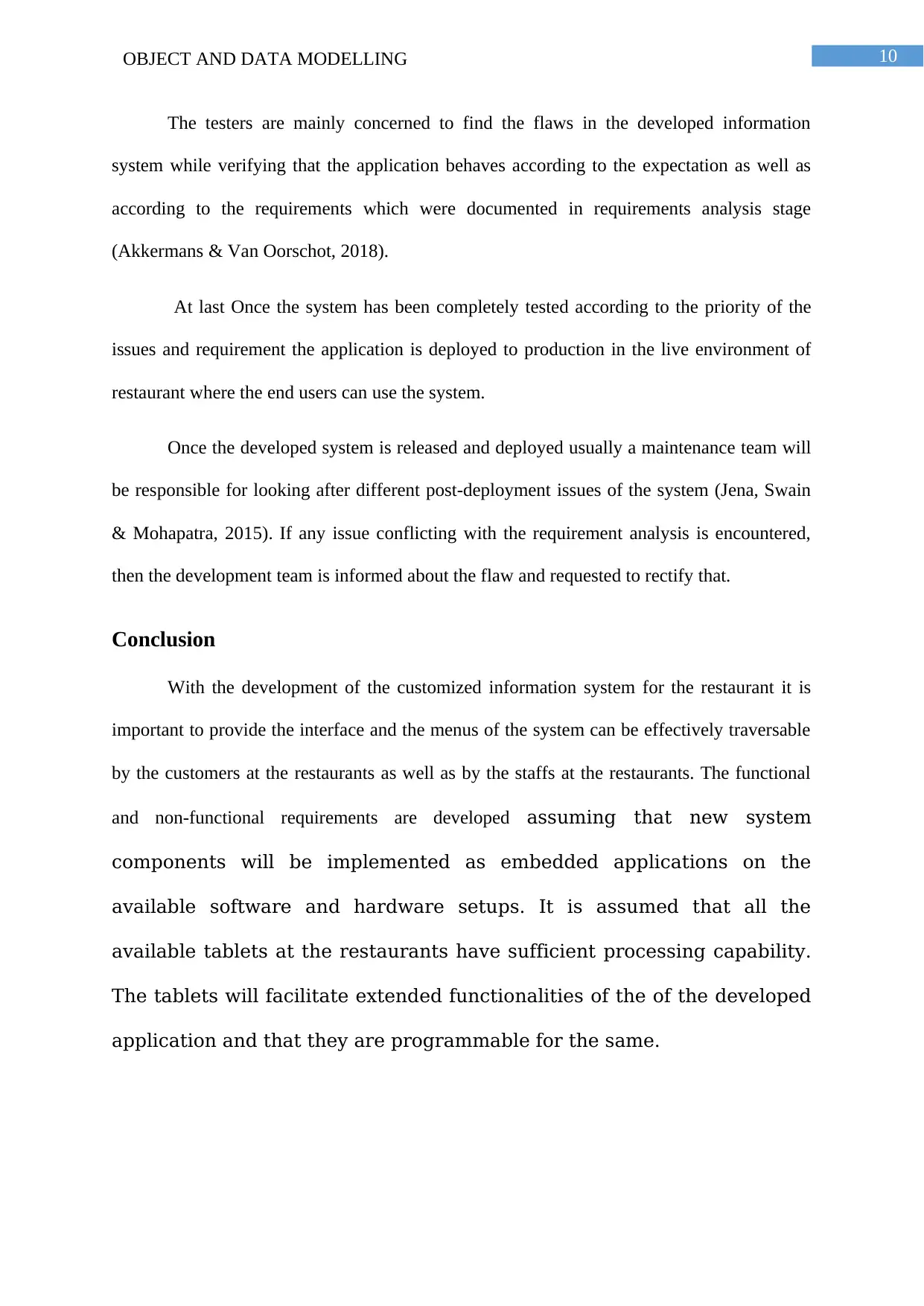
10OBJECT AND DATA MODELLING
The testers are mainly concerned to find the flaws in the developed information
system while verifying that the application behaves according to the expectation as well as
according to the requirements which were documented in requirements analysis stage
(Akkermans & Van Oorschot, 2018).
At last Once the system has been completely tested according to the priority of the
issues and requirement the application is deployed to production in the live environment of
restaurant where the end users can use the system.
Once the developed system is released and deployed usually a maintenance team will
be responsible for looking after different post-deployment issues of the system (Jena, Swain
& Mohapatra, 2015). If any issue conflicting with the requirement analysis is encountered,
then the development team is informed about the flaw and requested to rectify that.
Conclusion
With the development of the customized information system for the restaurant it is
important to provide the interface and the menus of the system can be effectively traversable
by the customers at the restaurants as well as by the staffs at the restaurants. The functional
and non-functional requirements are developed assuming that new system
components will be implemented as embedded applications on the
available software and hardware setups. It is assumed that all the
available tablets at the restaurants have sufficient processing capability.
The tablets will facilitate extended functionalities of the of the developed
application and that they are programmable for the same.
The testers are mainly concerned to find the flaws in the developed information
system while verifying that the application behaves according to the expectation as well as
according to the requirements which were documented in requirements analysis stage
(Akkermans & Van Oorschot, 2018).
At last Once the system has been completely tested according to the priority of the
issues and requirement the application is deployed to production in the live environment of
restaurant where the end users can use the system.
Once the developed system is released and deployed usually a maintenance team will
be responsible for looking after different post-deployment issues of the system (Jena, Swain
& Mohapatra, 2015). If any issue conflicting with the requirement analysis is encountered,
then the development team is informed about the flaw and requested to rectify that.
Conclusion
With the development of the customized information system for the restaurant it is
important to provide the interface and the menus of the system can be effectively traversable
by the customers at the restaurants as well as by the staffs at the restaurants. The functional
and non-functional requirements are developed assuming that new system
components will be implemented as embedded applications on the
available software and hardware setups. It is assumed that all the
available tablets at the restaurants have sufficient processing capability.
The tablets will facilitate extended functionalities of the of the developed
application and that they are programmable for the same.
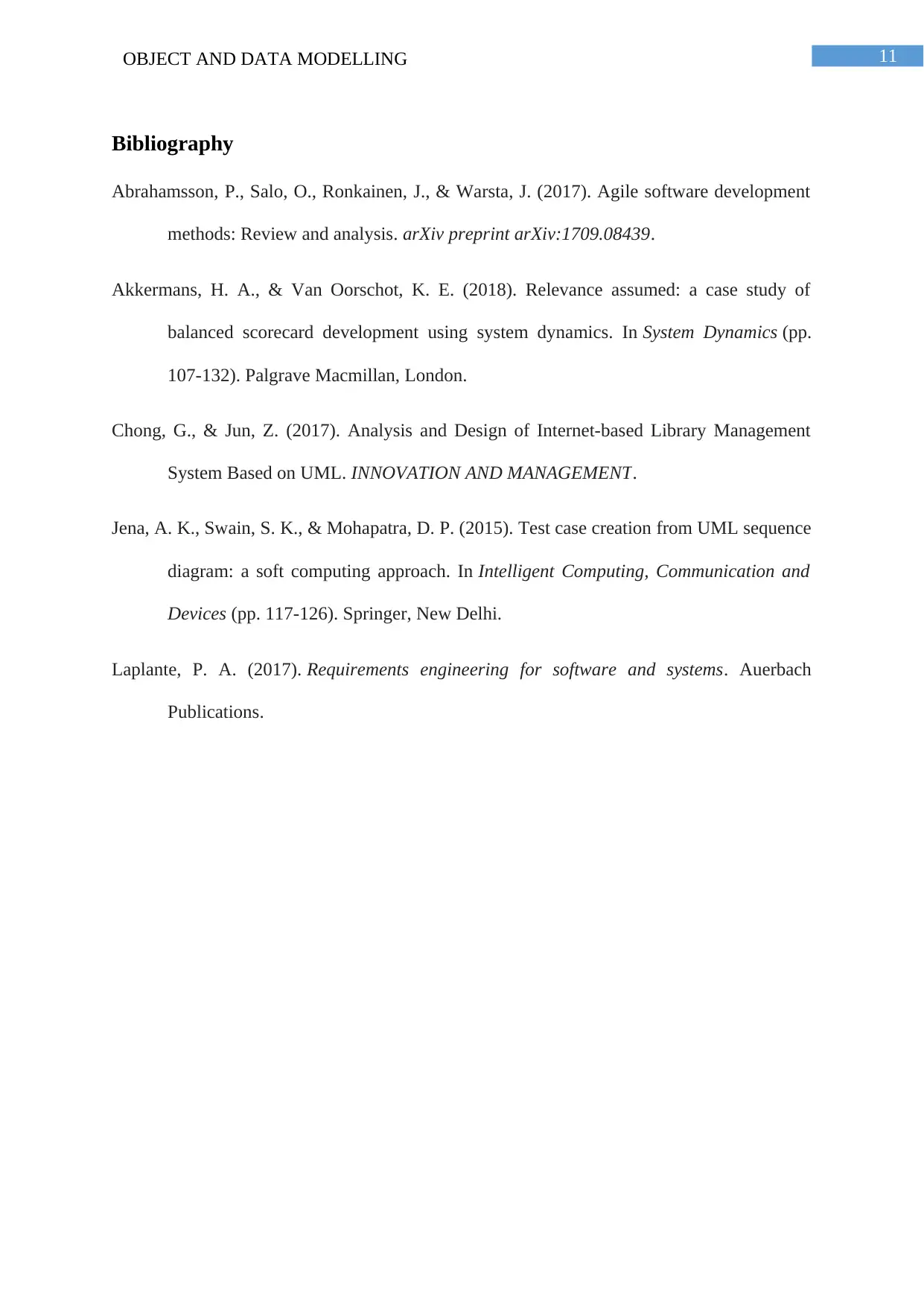
11OBJECT AND DATA MODELLING
Bibliography
Abrahamsson, P., Salo, O., Ronkainen, J., & Warsta, J. (2017). Agile software development
methods: Review and analysis. arXiv preprint arXiv:1709.08439.
Akkermans, H. A., & Van Oorschot, K. E. (2018). Relevance assumed: a case study of
balanced scorecard development using system dynamics. In System Dynamics (pp.
107-132). Palgrave Macmillan, London.
Chong, G., & Jun, Z. (2017). Analysis and Design of Internet-based Library Management
System Based on UML. INNOVATION AND MANAGEMENT.
Jena, A. K., Swain, S. K., & Mohapatra, D. P. (2015). Test case creation from UML sequence
diagram: a soft computing approach. In Intelligent Computing, Communication and
Devices (pp. 117-126). Springer, New Delhi.
Laplante, P. A. (2017). Requirements engineering for software and systems. Auerbach
Publications.
Bibliography
Abrahamsson, P., Salo, O., Ronkainen, J., & Warsta, J. (2017). Agile software development
methods: Review and analysis. arXiv preprint arXiv:1709.08439.
Akkermans, H. A., & Van Oorschot, K. E. (2018). Relevance assumed: a case study of
balanced scorecard development using system dynamics. In System Dynamics (pp.
107-132). Palgrave Macmillan, London.
Chong, G., & Jun, Z. (2017). Analysis and Design of Internet-based Library Management
System Based on UML. INNOVATION AND MANAGEMENT.
Jena, A. K., Swain, S. K., & Mohapatra, D. P. (2015). Test case creation from UML sequence
diagram: a soft computing approach. In Intelligent Computing, Communication and
Devices (pp. 117-126). Springer, New Delhi.
Laplante, P. A. (2017). Requirements engineering for software and systems. Auerbach
Publications.
⊘ This is a preview!⊘
Do you want full access?
Subscribe today to unlock all pages.

Trusted by 1+ million students worldwide
1 out of 13
Related Documents
Your All-in-One AI-Powered Toolkit for Academic Success.
+13062052269
info@desklib.com
Available 24*7 on WhatsApp / Email
![[object Object]](/_next/static/media/star-bottom.7253800d.svg)
Unlock your academic potential
Copyright © 2020–2025 A2Z Services. All Rights Reserved. Developed and managed by ZUCOL.





